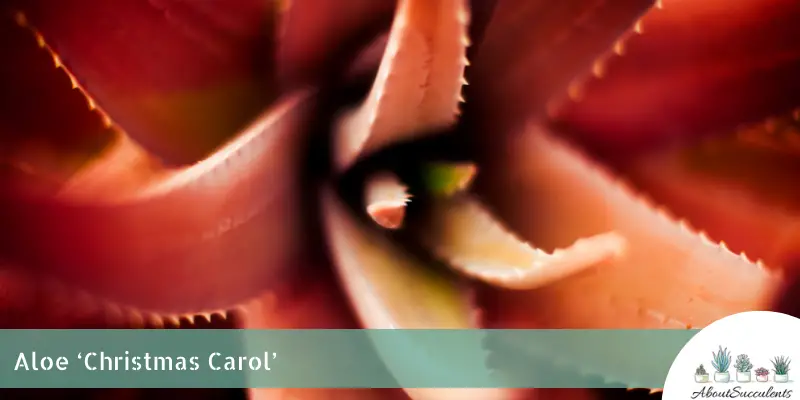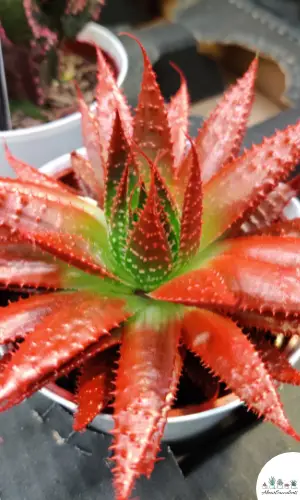
There’s a reason this Aloe is called “Christmas Carol” and it’s because the red and green colored succulent grows to the shape of a star.
It’s a type of succulent that not only brings style, grace, and elegance to a table arrangement but Aloe “Christmas Carol” will certainly encourage a cheerful and joyful mood among your guests.
The triangular-shaped leaves of Christmas Carol are also characterized by yellow bumps that congregate in the middle and line up along its borders. With proper sun exposure, the leaves can take on the color purple.
Aloe Christmas Carol can reach a height and width of 15cm (6”) and produces red-pink flowers in the fall.
The adorable succulent is a hybrid that was developed by Kelly Griffin with Aloe “Doran Black” as the parent. This means Aloe Christmas Carol has its roots in Madagascar.
Aloe Christmas Carol belongs to the Asphodelaceae family.
General Information:
Also known as: Christmas Carol
Plant Family: Asphodelaceae
Origin: Madagascar
Height: 15cm (6”)
Exposure: Full to partial sun; 6 hours per day
Water Needs: Typical succulent needs; water only when the soil is completely dry.
Soil Type: Standard potting soil mix with added ingredients such as turface and crushed granite.
Soil pH: 6.0 to 8.5
How to Grow and Care for Aloe “Christmas Carol”
If you’re thinking about a type of succulent plant for your garden or for the indoors, you can’t go wrong with Aloe Christmas Carol.
Succulent hobbyists popularly use Aloe Christmas Carol as a table arrangement during the “most wonderful time of the year”. It can also be used as ground cover or as part of your rock garden.
This is a slow-growing succulent that is easy to grow for provided you closely follow our simple care tips.
Sunlight
It might be identified with the “Star of Bethlehem” but Aloe Christmas Carol needs the morning sun!
Plant Aloe Christmas Carol in an area in the garden that gets 6 hours of sunlight every day. The succulent will thrive in direct exposure but will do fine with partial sunlight.
Avoid exposing Aloe to the rays of the afternoon sun as the scorching heat can burn its beautiful leaves.
When grown indoors, place Christmas Carol near a window that gets 4 to 6 partial sunlight per day. If this is not possible, buy a Grow Light and give Aloe regular exposure.
Watering

Aloe Christmas Carol requires the typical watering needs of succulent plants. It grows better when given less water. If you overwater the soil, the plant’s roots will rot and this will lead to the development of a fungal infection.
Always check the dryness of the soil before giving Aloe water. The best way to know if the soil is dry enough is to insert a stick. Pull out the stick and if its end feels dry, water the soil until it’s fully soaked through.
Christmas Carol will have a lighter watering schedule during the winter months as the soil tends to retain moisture longer.
Pot and Soil
Aloe Christmas Carol is not a cold-hardy plant. If the temperature in your region falls below -1.1° C (30° F), it would be best to plant Aloe in a pot that you can easily move from the garden to inside your home.
Choose a pot made from ceramic or terracotta as these materials support the timely evaporation of moisture from the soil. Also, make sure that the pot has a drain hole with a mesh cover at the bottom.
Plant Aloe in a standard potting mix and add ingredients such as turface and crushed granite to improve the level of drainage.
Fertilizer is not a must but a big plus to give the soil extra nutrients. You can fertilize once during the growing season but never during winter.
How to Propagate Aloe “Christmas Carol”
Aloe Christmas Carol will give you the gift of offsets to make it easier for you to propagate the species of succulent.
Method 1: Offsets
Step 1: Gently pull out the offsets growing near the base of the plant. You can also cut them off with a sterilized but sharp pair of gardening scissors.
Step 2: Place the offsets in a warm and dry place to allow them to develop hard calluses. This process might take 2 to 3 days.
Step 3: Plant the callused offsets in well-draining soil.
Step 4: Water the soil only when it has gone completely dry.
Frequently Asked Questions
Is Aloe “Christmas Carol” Toxic to Cats and Dogs?
Aloe Christmas Carol is not specifically identified on the list of toxic plants on the website of the American Society for the Prevention of Cruelty to Animals (ASPCA).
Keep in mind that this is just a partial list and some Aloe succulents have shown toxicity to animals. As an indoor plant, place Christmas Carol in a location that can’t be reached by your pets.
If your pet has no appetite, has exhibited vomiting or diarrhea recently, don’t take chances and bring the animal to the veterinarian immediately.
Why Is My Aloe “Christmas Carol” Dying?
Overwatering and the existence of pets can kill Aloe Christmas Carol.
Overwatering
When the roots of Aloe are kept in a moist environment for an extended period, they will rot and develop fungal infections that will spread rapidly throughout the plant.
If you see discolored leaves or stems, cut them off with a pair of sharp and sterilized gardening scissors. The next step is to remove the plant from the soil and examine its roots. Cut off all rotting roots.
Prepare a pot with fresh soil and replant Aloe Christmas Carol.
Pest Infestation
Insects such as mealybugs, aphids, and spider mites are natural enemies of Aloe Christmas Carol. These insects will drain your plant of nutritious sap and leave it withered, weak, and susceptible to infection.
Spray the succulent plant with neem oil to keep pests away. If you see white, cotton-like substances on Christmas Carol’s leaves, these are evidence that mealybugs are squatting in Aloe.
You can wipe the leaves with 70% isopropyl alcohol or with insecticide soap.
Does Aloe “Christmas Carol” Produce Flowers?
Yes, Aloe Christmas Carol blooms quaint red-pink flowers during the fall season.
Last Updated on June 9, 2022 by Sofia Lara